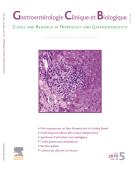Reactive nodular fibrous pseudotumor: A first report of gastric localization and clinicopathologic review - 09/12/09
 , A. Bressenot a, T. Serradori b, P. Boissel b, F. Plénat a, K. Montagne a
, A. Bressenot a, T. Serradori b, P. Boissel b, F. Plénat a, K. Montagne aSummary |
Reactive nodular fibrous pseudotumor (RNFP) of the gastrointestinal tract is a distinct benign lesion, which could originate from a reactive proliferation of multipotential subserosal cells. This is the first case to be reported in the stomach. It was fortuitously discovered in a 60-year-old man with history of bulbar ulcer and gastritis. Gross examination revealed three lesions in the gastric wall and an adjacent lesion in the lesser omentum. Histologically, lesions were composed of a proliferation of spindle and stellate cells in a dense collagenic hyalinized background containing a mononuclear cell inflammatory infiltrate with numerous lymphoid aggregates and plasma cells with perivascular disposition. Immunohistochemistry showed staining for cytokeratins (AE1/AE3), vimentin and smooth muscle actin, without staining for the neurofilament and S100 proteins, synaptophysin, calretinin, CD117 (c-kit), CD34, desmin, caldesmon or anaplastic lymphoma kinase (ALK-1). Complete excision was performed, and no evidence of disease was found 4 months later. After analysing clinical, morphological and immunohistochemical features of this entity, the main differential diagnoses will be discussed, including calcifying fibrous pseudotumor, which shares morphological characteristics with RNFP, but which immunohistochemistry and the ultrastructural study suggest that it may be a result of another reactive process.
Il testo completo di questo articolo è disponibile in PDF.Résumé |
La pseudotumeur fibreuse nodulaire réactionnelle (PFNR) du tractus gastro-intestinal est une lésion bénigne qui résulterait d’une prolifération de cellules multipotentes sous-séreuses. Nous rapportons un premier cas de localisation gastrique, de découverte fortuite chez un patient de 60 ans aux antécédents d’ulcère bulbaire et de gastrite. L’examen macroscopique mettait en évidence trois lésions de la paroi gastrique et une lésion du petit épiploon. Histologiquement, ces lésions étaient composées d’une prolifération de cellules fusiformes et étoilées dans un stroma collagène dense et hyalinisé, s’accompagnant d’un infiltrat inflammatoire mononucléé avec de multiples follicules lymphoïdes et des plasmocytes de disposition périvasculaire. L’étude immunohistochimique montrait une expression des cytokératines (AE1/AE3), de la vimentine et de l’actine musculaire lisse, sans marquage pour les protéines S100 et du neurofilament, la synaptophysine, la calrétinine, la desmine, la caldesmone, anaplastic lymphoma kinase (ALK-1), CD117 (c-kit) et CD34. L’exérèse était complète. On ne constatait aucune récidive après un suivi de quatre mois. Après avoir analysé les aspects cliniques, morphologiques et immunohistochimiques de cette entité, nous discuterons des diagnostics différentiels et en particulier de la pseudotumeur fibreuse calcifiante. Celle-ci est morphologiquement proche de la PFNR, mais, d’après ses caractéristiques immunohistochimiques et ultrastructurales, pourrait résulter d’un processus réactionnel distinct.
Il testo completo di questo articolo è disponibile in PDF.Mappa
Vol 33 - N° 12
P. 1076-1081 - Dicembre 2009 Ritorno al numeroBenvenuto su EM|consulte, il riferimento dei professionisti della salute.

